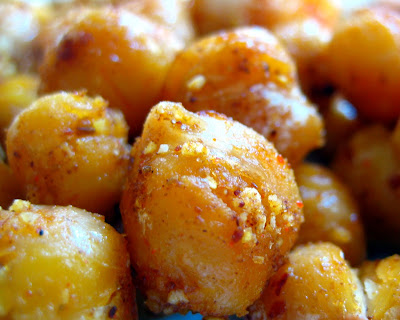At some point last week, I decided it was about time to learn to soak my own beans. Now, if you've soaked beans before, you probably think this is about as momentous an announcement as someone declaring they've decided to stamp their own envelope in the old-fashioned, lick-it-yourself sort of way.

But, if you're like me and tend to assume beans grow in cans in the supermarket aisle, you may not yet know that home-soaked beans (or home-grown beans, as my husband dubbed them after noting that they grew to twice their initial size after soaking and had therefore been grown, in the home -- can't argue with that) are (a) simple to prepare (kind of embarrassingly simple, actually, in light of the fact that I had never considered doing it before), (b) way cheaper, especially for anyone moving their culinary practices in an eat-food-mostly-plants sort of direction, and (c) way tastier. This last one nobody told me, which has me slightly irked because I'm pretty sure I would have done this sooner if they had. Although maybe I wouldn't have believed it could make that much of a difference. But apparently home "grown" beans have an entirely different taste, and texture, than their canny canny cousins.
So, I soaked some cannellini beans last week, and got hooked, and yesterday morning found me trying my hand at chickpeas. Which were again incredibly easy. If (like me) you have no clue how to do this, here's a cheat sheet:
1. Rinse a bunch of dried chickpeas, checking through them carefully for stones
2. Throw in a pot of water (the water should be several inches above the beans, because they'll expand quite a bit), bring to a boil, and boil for two minutes
3. Turn off the heat and let them to soak for about two hours (you can also just let them soak in cold water overnight, instead)
4. Drain and rinse the beans, then add them back to the pot with some fresh water and a few whole peeled cloves of garlic, and simmer them for another 60-80 minutes until they're tender
5. Drain and stick in the fridge until you're ready to use them
6. Optional, but highly recommended: Make the following recipe. Which turned out to be...well, what the title says.
Ingredients
3 cups cooked chickpeas (soaked and cooked yourself, else canned)
1 Meyer lemon, zested and cut in half
2 cloves garlic, pressed
Salt & pepper
Ñora pepper (optional)
1 yellow onion, chopped
3/4 cup black Forbidden rice (could substitute brown basmati rice & adjust the cooking time)
Saffron threads
Scant 1/2 tsp cumin seeds (or two generous pinches)
Scant 1/2 tsp yellow mustard seeds (or two generous pinches)
1/4 cup broth or water
3/4 cups cooked chopped spinach (frozen works: thaw for 2 minutes in the microwave and then drain. If fresh, blanch, drain, then chop)
1/4 tsp ground turmeric
Aleppo or other hot pepper, to taste
Pinch or two ground cumin
Pinch or two sweet paprika
Whisk the juice of half the lemon with a generous glug of olive oil in a bowl. Add the garlic, a pinch of salt, and some black pepper and ñora pepper if you have it. Add the chickpeas, stir to coat, and marinate in the fridge for about half an hour.
Saute about a quarter of the chopped onion in a small pot over medium heat until it softens. Add the black rice and a pinch of saffron and cook, stirring, for a minute or two, then add a little less than one cup of water. Cover, bring to a boil, then turn heat down and simmer for 20 minutes or until done. (If there is extra liquid left at the end, uncover, turn heat to medium, and cook for another minute, stirring to evaporate the water.)
Meanwhile, heat about 2 tbsp olive oil in a wide pan over medium-high heat. When hot, add the cumin and mustard seeds and toast until they start to pop (about 10-20 seconds). Immediately add the rest of the onion and cook, stirring, for several minutes. Just as it starts to brown, add the chickpeas (and a little more olive oil if it's too dry) and cook, stirring occasionally, for about 3 more minutes.

Next, add the spinach, turmeric, a pinch or two of salt, pepper, and Aleppo. Cook, stirring, for a few more minutes, adding the broth as it starts to get dry. (Depending on how cooked your chickpeas were to begin with, you may want to cover the pan and let it simmer for a couple minutes at this point.)
Add the cooked rice, stir, and cook for a minute or two until heated through. Then dust with a bit of cumin and just a little paprika. Add the lemon zest, cook for about 30 more seconds, and then turn off the heat. Cover pan and let sit for 10 minutes to blend the flavors. Adjust salt and pepper to taste.
Serve hot or at room temperature, garnished with a lemon wedge. Goes well with roasted carrots with cumin seeds (below).
Serves 3-4 (or 2 for dinner with some leftovers)


































